introduction
Â
Hundreds of volts of DC power is not as common as one might think. Perhaps one of the first applications to come into mind is the electric car, in which the lithium-ion battery pack has a voltage range of up to 400V. However, some of the lesser-known high-voltage applications appear in modern fighters, such as the F-22 Raptor and the F-35 Lighting II, which are powered primarily by 270V DC power supplies. Achieve faster, more accurate performance. Large solar arrays can output 600V or higher, while AC voltage rectification in industrial motor drives produces DC voltages ranging from 170V to 680V. For many years, research and development efforts have been carried out to change the power distribution of the data center from AC to high-voltage DC (380V or ±190V), thereby reducing power conversion steps, equipment footprint and operating costs, while facilitating renewable with solar energy. Energy integration. The higher voltage distribution reduces the current value, which reduces the resistive loss ( I2 • R), which can be used to reduce cable weight. All of these high voltage power supplies require switching and soft start to power the load. In terms of energy monitoring and optimization, it is essential to digitally monitor the voltage and current on the high voltage bus. Any circuit that controls these power supplies must be electrically isolated to ensure operator safety and to protect low voltage electronic components from dangerous high voltages.
Method of controlling surge current and monitoring power supply
Â
When designing a high voltage power supply, an important goal is to safely control the starting surge current into the capacitive load, such as the DC bus capacitors that follow the typical bridge rectifier. An easy way to reduce the inrush current is to use a negative temperature coefficient (NTC) thermistor, also known as an inrush current limiter (ICL, Figure 1a). These thermistors have a large resistance (for example, a few ohms) at room temperature before the power supply or load is turned on; the large resistance limits the inrush current when it is turned on. As the current flows, the thermistor temperature rises and its resistance decreases by one to two orders of magnitude (reduced to 1/10 to 1/100, becoming less than 1 ohm). These thermistors range in price from $0.13 to $7 each, depending on current and resistance ratings. Although easy to use, the problem is that a fast power cycle (on-off-on) may not limit the inrush current during the second power up because the thermistor may not have enough time to cool to large Resistance state. NTC thermistors have a wide tolerance (±25%), and because the inrush current is related to the steady-state current through the rate of resistance drop, the inrush current cannot be flexibly adjusted to any low value. ICLs are used in vacuum cleaners, fluorescent lamps, and switch mode power supplies to reduce the inrush current of bridge rectifier DC bus capacitors.
Â
To overcome the shortcoming of the NTC thermistor with no inrush current limitation during a fast restart, a shorting relay in parallel with the resistor is used. This relay is called a step start relay (Figure 1b). When connected, the parallel repeater is open and the inrush current is limited by the resistor. A timer is also activated at the same time. When the timer expires, the relay is shorted to the resistor. The load current now flows through the relay. The step start relay provides a surge limit during a fast restart. This method requires the addition of a shorting relay and a timer that controls the relay to turn on. As the complexity increases, the cost of the solution increases to the $20 to $30 range.
Â
Other inrush current control methods include zero-crossing thyristors, active power factor control circuits, and damped inductive input filtering. Most of these methods are complex, cumbersome, expensive, and only available for AC input.
Â
One method for isolated current monitoring is to use an isolation amplifier across the current sense resistor and feed the ADC with a differential to single-ended conversion amplifier. Another method is to use an isolated incremental accumulation (ΔΣ) modulator and an external digital filter.
Â
As has been seen, controlling, protecting, and monitoring high-voltage DC power supplies requires a lot of components to be put together and these components run safely and seamlessly. This is not a trivial task. These discrete solutions are large, component intensive, expensive, and lack security certification. There is a need for an integrated and certified solution to reduce design time and certification from multiple months to weeks.
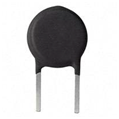
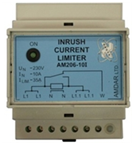
Figure 1: Surge control limiter. (a) Negative temperature coefficient (NTC) thermistor; (b) Step start relay
Integrated solution for high voltage power control and telemetry
Â
The LTM9100 μModule ® IC is a compact, all-in-one solution for controlling, protecting and monitoring DC high voltage power supplies up to 1000V (Figure 2a). The 5k VRMS isolation barrier isolates the logic and digital interfaces from the switching controller that drives the external N-channel MOSFET or IGBT switch. This isolation is required to control circuit protection, operator safety, and disconnect ground paths. The load is soft-start (Figure 2b), which protects the power supply from current-limiting circuit breakers for overload. The power, energy and heat monitoring of the high voltage bus is achieved by accessing the two voltage inputs and the load current values ​​measured with the isolated 10-bit ADC through the I2C / SMBus interface.
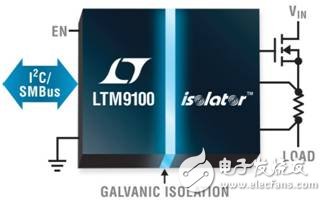
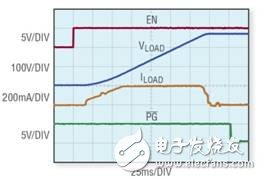
Figure 2: (a) LTM9100 AnysideTM High-Voltage Isolated Switch Controller with Telemetry (b) LTM9100 Soft-Start, 270V Load and 200mA Controlled Surge Current
The LTM9100 uses Linear Technology's isolator μModule technology to convert signals and power across an isolation barrier. The signal is encoded as a pulse and transmitted through the isolation boundary using a coreless transformer formed in the μModule substrate, resulting in an extremely robust two-way communication scheme. Uninterrupted communication is guaranteed with common mode transients up to 50kV/μs. Power is supplied to the isolated side by a fully integrated DC/DC converter including a transformer, eliminating the need for additional external components. To ensure the robustness of the isolation barrier, each LTM9100 controller is tested at production and has an isolation performance of 6k VRMS . The LTM9100 will be approved by the UL 1577 standard, saving end-equipment manufacturers months of certification time. The high feedthrough insulation distance translates to ±20kV high ESD protection on both ends of the isolation barrier. The μModule package combines several components and technologies to provide a cost-effective, advanced solution that minimizes board space and improves electrical and thermal performance.
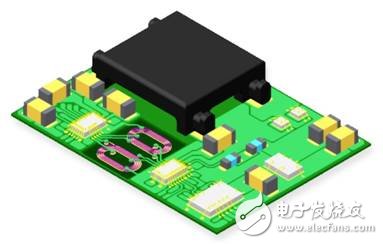
Figure 3: Linear Technology's isolator μModule technology internal structure
Due to its isolation, the LTM9100 is easily configured for high side, low side (ground loop) and floating applications (Figure 4). The LTM9100 is versatile enough to control inrush currents not only in hot-swappable boards, but also in AC transformers, motor drives, and inductive loads. Adjustable undervoltage and overvoltage lockout thresholds ensure that the load only operates when the input supply is within the valid range. The 22mm x 9mm x 5.16mm BGA package provides a 14.6mm creepage distance between the logic side and the isolated side.
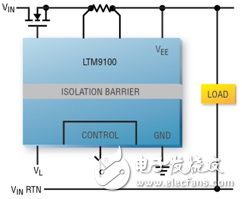
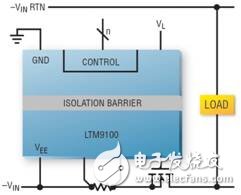
Figure 4: LTM9100 for high side or low side switch applications
in conclusionTraditionally, high voltage DC power supplies have been used in industrial environments, but other electronic systems are also moving toward higher voltages to reduce distribution costs and increase their efficiency, especially in systems that consume large amounts of power. This type of power supply requires an easy way to control the inrush current, protect the power supply itself, and monitor the use of the power supply. The LTM9100 is the first of its kind to offer this simple, compact solution that saves board space and months of design time by providing a proven solution that outperforms discrete and relay-based circuits And certification work. All the features required, including digital telemetry and isolated power supplies, are integrated into a compact, surface-mount flat BGA package.
GALOCE Various products of Crane Scale, hanging scale, providing product images and basic parameters with each Electronic Crance Scale and Digital Crane Scale; We are a professional Chinese manufacturer of Crane Scale, Wireless Load Cell, and Wireless Dynamometer, and look forward to your cooperation!
Crane Scale,Crane Weight Scale,Crane Load Cell,wireless dynamometer
GALOCE (XI'AN) M&C TECHNOLOGY CO., LTD. , https://www.galoce-meas.com
